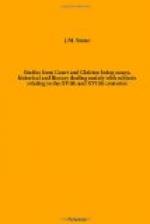A cheap edition had already appeared in 1868 with a preface by the Bishop of Carlisle in which his lordship said that:—
“The Convocation of the English clergy did wisely, when in the days of Elizabeth, they enacted that every parish Church [sic] in this land should be furnished with a copy of Foxe’s Book of Martyrs.”
There is also an illustrated edition published by Messrs Cassell; and the Religious Tract Society still continues to make the Acts and Monuments the subject of a quiet but active propaganda in evangelical interests, offering the book at a reduced price to students, teachers, and public libraries, sometimes even presenting it as a free gift.
IV. THE SPOILS OF THE MONASTERIES
The great, perhaps the sole repositories of the early historical and topographical records of England, Scotland, and Ireland, from the introduction of Christianity until the introduction of printing, were the monasteries. Throughout the middle ages these libraries were the homes, in many instances the birthplaces of treasures which would have been hopelessly lost or destroyed in those rough times but for the shelter thus afforded them. The monks were constantly employed in writing, copying, and ornamenting manuscripts, while State papers and parliamentary rolls were deposited in their archives for safety. Moreover, as they were known to be rich, and to care for such things, books were brought to them from time to time for sale by those in need of money. There was scarcely any religious house but had a library, and many of them were very good ones. Some data have come down to us by which we can form an estimate of their bulk and value.
The books which St. Augustine brought with him from Rome, together with those of Theodore, formed the nucleus of the well-known monastic library at Canterbury. In the library at Peterborough there were no fewer than 1700 MSS. That of the Grey Friars in London was 129 feet long by 31 feet broad, and was well filled with books. That the Abbey of Leicester and the Priory of Dover had no mean libraries appears from the catalogues of their books yet remaining in the Bodleian. Ingulf tells us that when the library at Croyland was burned in 1091, the monks lost 700 books. The great library at Wells had twenty-five windows on each side, a fact which gives us some notion of the space required to contain all the volumes possessed by this monastery.*
* Tanner, Nolitia Monastica, preface, p. xl., edited 1744.
In the English preface to Dugdale’s Monasticon mention is made of the “incredible number of books written by the monks,” and it would be easy to multiply illustrations of this kind, and to collect notes of the indiscriminate destruction that took place at the dissolution of the monasteries under Henry VIII., when the contents of these libraries were sold as waste paper.




